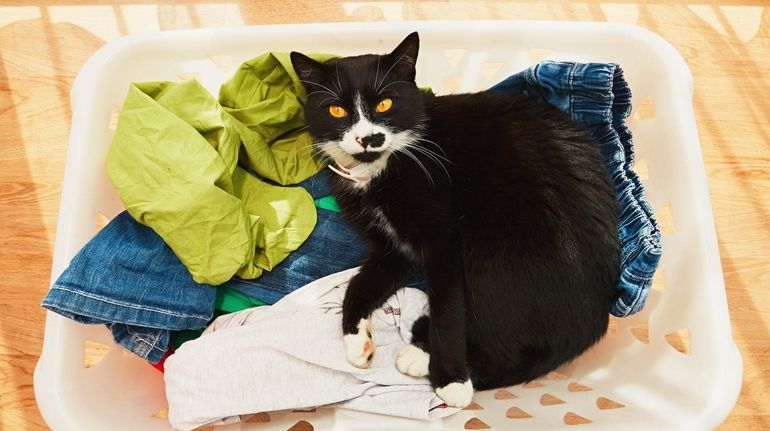When the cat dirties the laundry

Some cats like to laze, and urinate, in a basket of dirty laundry. Credit: Getty Images/iStockphoto
Q One of my cats is peeing in my son's laundry basket full of clothes. He has always treated her fine, so this isn't a personality problem. We keep his bedroom door shut, but somehow, every once in a while, when it is left open, it happens again. Is there some kind of repellent I can use to keep her out of his room? It has become so ingrained in her I don't think she can be trained to stop.
— Sue, Chino Valley, Arizona
Only 25¢ for 5 months
Q One of my cats is peeing in my son's laundry basket full of clothes. He has always treated her fine, so this isn't a personality problem. We keep his bedroom door shut, but somehow, every once in a while, when it is left open, it happens again. Is there some kind of repellent I can use to keep her out of his room? It has become so ingrained in her I don't think she can be trained to stop.
— Sue, Chino Valley, Arizona
A Cats peeing on dirty laundry, bathmats, and even bed linens while the linens are still on the bed are not uncommon feline behaviors. No one knows for sure why cats do this, but they may not like the smell of the laundry or the smell or location of their litter box. They may be reacting to stress, which is often the result of change in the home, like the addition of a new baby, new furniture or a move to a new home. They may even have a health problem that requires medical attention.
If it's not a health problem, there are a few things you can do to discourage the behavior. The most obvious is keeping the cat out of your son's room and dirty laundry up off the floor. Since that is difficult to do, switch the laundry basket to a closed hamper or consider using feline motion sensor spray deterrents or spray repellents near the laundry basket to discourage her from approaching the laundry altogether.
Q I picked up a 5-month-old golden retriever puppy, and am ready for her with a crate, toys, water and food dishes. I have been reading suggestions on where and when to crate her, and when and when not to lock her in the crate. Some suggest next to my bed, which in my case is possible, but not practical. Some say keep her and the open crate in a small cordoned off area with the crate open where she can see me most of the time. I want to train her right. Any suggestions?
— Jeffrey, Holtsville
A You may already be past the first few days of crate-training but always start with the crate in your bedroom for the first week. If the crate won't fit, put it in the family room and sleep on the couch for a few days. The idea is to be near her, so she is not anxious those first few days.
After the initial adjustment period, put the crate in an area that is not high traffic, but near where you hang out most of the time, like the main living space of your home. Never seclude a dog in a crate in another room. If your dog can't see you, she may develop separation anxiety.
As far as time in the crate, a puppy shouldn't be in a crate for more than a few hours at a time with plenty of time in between for play and exercise. If you're using the crate only at night, a late nighttime pee should carry most large breed puppies until the wee hours of the morning. If you are using the crate during the day, then she will need a break every few hours to go outside and relieve herself. Do not leave her in the crate most of the day and all night. It can be very hard on a puppy or dog to be crated all the time. Hire a pet sitter to come by and play with her so that she has plenty of exercise and outdoor time if you are not home or can't get home to let her out.
Teach her to go into the crate when you ask by saying "kennel" or "crate." Some people say "go to bed," but that is something you would tell a child and we don't want to confuse your dog.
Finally, make sure she loves her crate. You can do this by feeding her in her crate or giving her certain treats or special toys (like a Kong with frozen peanut butter) only when she is in her crate. Once she learns this crate is her special space, which may take a few months, you will be able to leave the crate door open and she will go to it just to hangout or take a nap. This is her special space, so don't let any child (or adult) bother her in this space.
Cathy M. Rosenthal is a longtime animal advocate, author, columnist and pet expert who has more than 25 years in the animal welfare field. Send your pet questions, stories and tips to cathy@petpundit.com. Please include your name, city, and state. You can follow her @cathymrosenthal.
